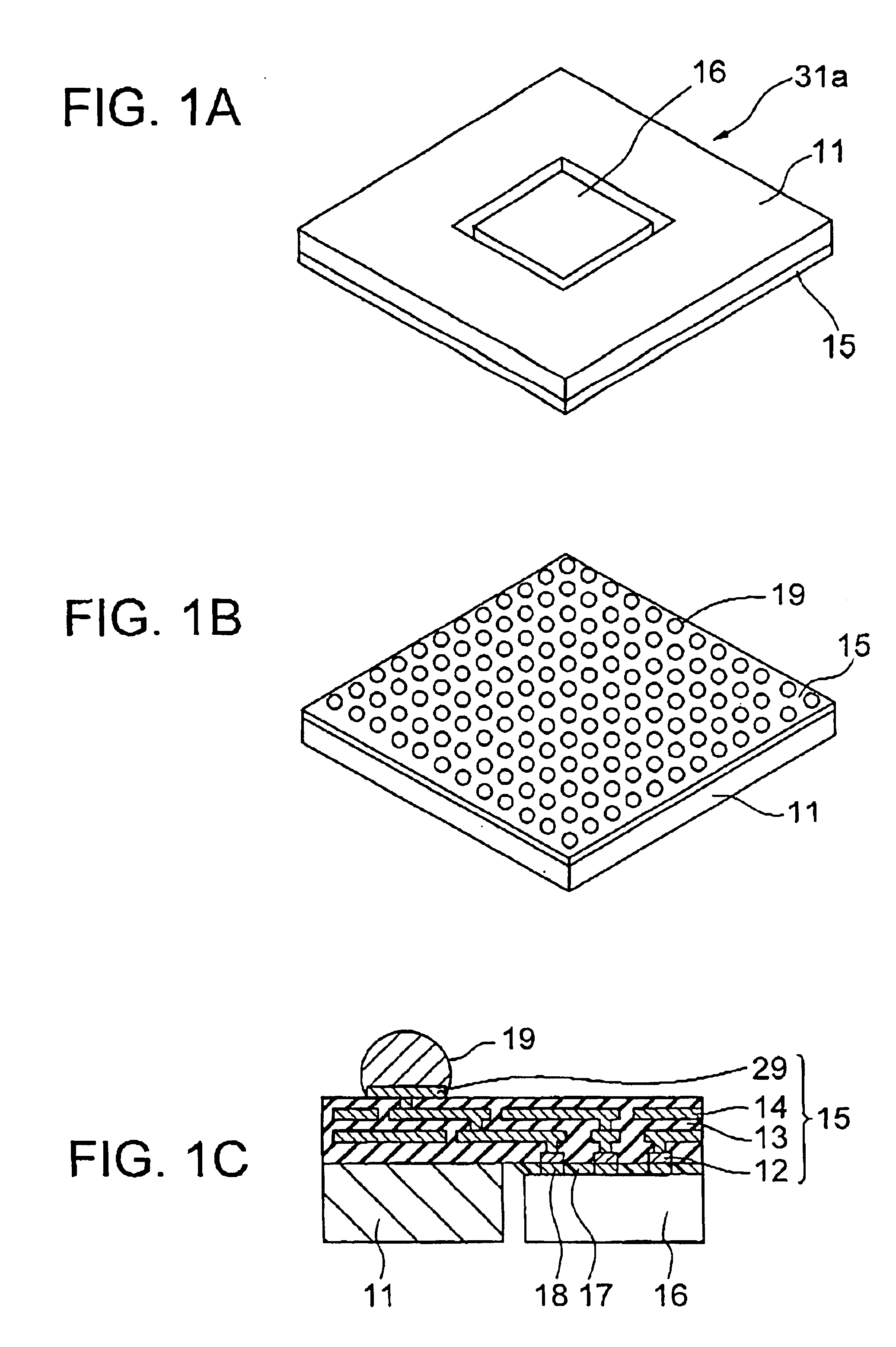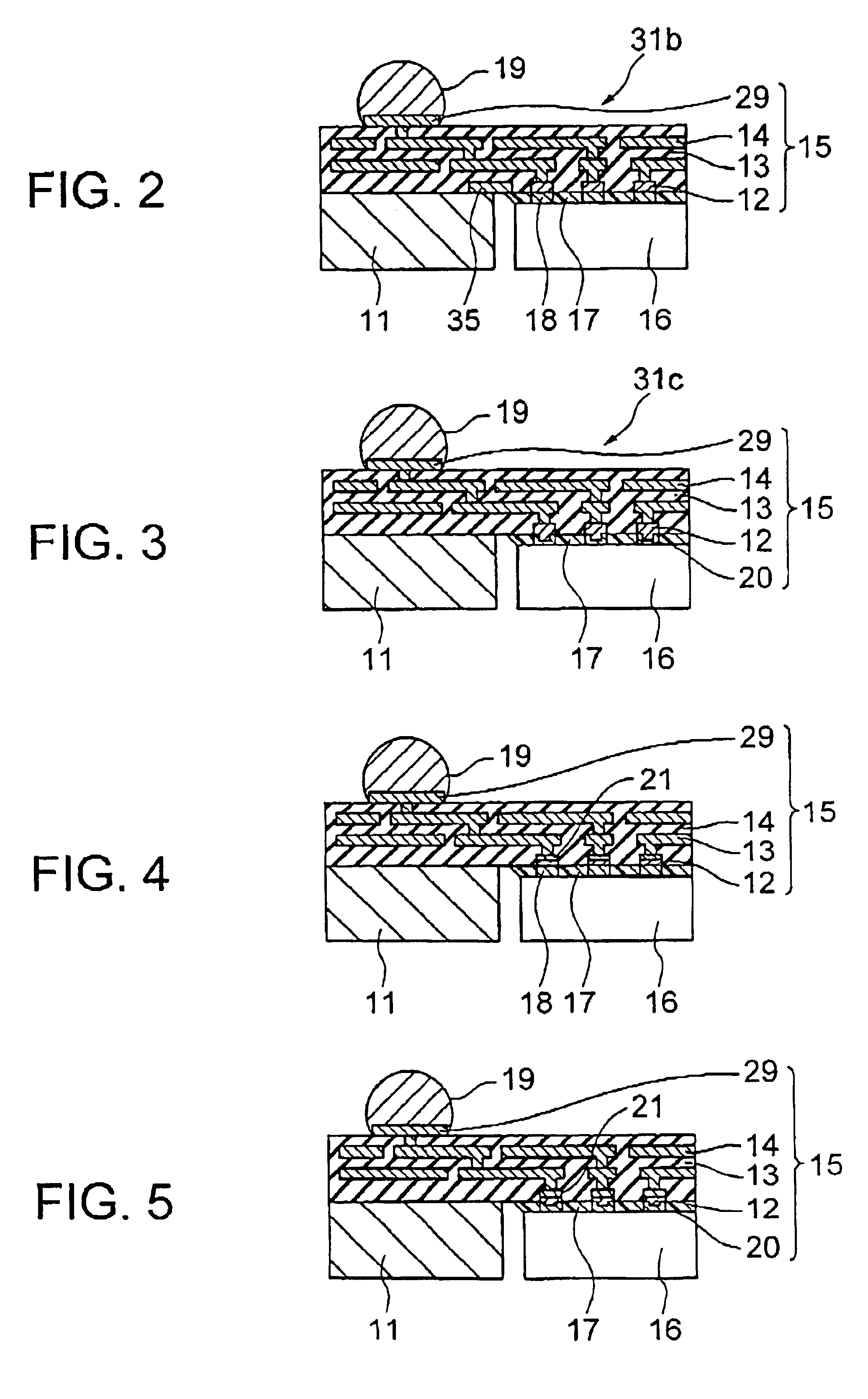Semiconductor package board using a metal base
a technology of semiconductor package board and metal base, which is applied in the direction of printed circuit manufacturing, printed circuit electric connection formation, printed circuit aspects, etc., can solve the problems of defective products, affecting the yield of ceramic multi-layer wiring board, and prone to chipping or cracking during fabrication and transfer, and achieves high reliability and superior smoothness.
- Summary
- Abstract
- Description
- Claims
- Application Information
AI Technical Summary
Benefits of technology
Problems solved by technology
Method used
Image
Examples
first embodiment
[0045]Referring to FIGS. 1A to 1C, a semiconductor device according to the present invention includes a full-grid ball grid array (BGA) chip 16 mounted on a multilayer wiring film 15 within a central opening of a metal base 11.
[0046]The metal base 11 having the central opening and the multilayer wiring film 15 mounted on the metal base 11 in combination constitute a semiconductor package board 31a of the present embodiment. The metal base 11 is formed as a metal plate attached with the multilayer wiring film 15. The opening of the metal base 11 receives therein the semiconductor chip 16, which is mounted on the multilayer wiring film 15. On the rear surface (top surface) of the multilayer wiring film 15 opposite from the front surface thereof where the metal base 11 and the semiconductor chip 16 are arranged, there are provided an array of second metal pads 29, on which an array of solder balls 19 which form a BGA structure are mounted.
[0047]On the front surface of the multilayer wi...
second embodiment
[0058]Next, a semiconductor package board or a semiconductor device according to the present invention will be described. FIG. 2 is a partial sectional view showing the structure of the semiconductor device using the semiconductor package board according to the present embodiment. The characteristic feature of the semiconductor package board according to the present embodiment is that a metallic film 35 is formed on the multilayer wiring film 15 at the periphery of the central opening of the metal base 11.
[0059]In the semiconductor device of the present embodiment, the semiconductor chip 16 is mounted on the semiconductor package board 31b within the central opening of the metal base 11. This structure is formed as follows. Specifically, the semiconductor chip 16 is disposed within the central opening of the metal base 11, and subjected to flip-chip bonding to the metal pads 12 disposed within the central opening by using solder balls 18. Subsequently, the underfill (or underfilling...
third embodiment
[0061]Next, a semiconductor package board according to the present invention will be described. FIG. 3 is a partial sectional view showing the structure of the semiconductor device using the semiconductor package board according to the present embodiment. The characteristic feature of the semiconductor package board according to the present embodiment is that solder balls 20 are provided on the surface of the metal pads 12 so as to protrude from the surface of the multilayer interconnection film 15.
[0062]The semiconductor device according to the third embodiment of the present invention includes a semiconductor package board 31c and a semiconductor chip 16 mounted thereon, and is assembled as follows. The semiconductor chip 16 is flip-chip bonded through solder balls 20 to the metal pads 12 arranged within the opening in the metal base 11 The semiconductor chip 16 may have the solder balls 18, in which case it is connected to the metal pads 12 through both the solder balls 18 and 20...
PUM
 Login to View More
Login to View More Abstract
Description
Claims
Application Information
 Login to View More
Login to View More - R&D
- Intellectual Property
- Life Sciences
- Materials
- Tech Scout
- Unparalleled Data Quality
- Higher Quality Content
- 60% Fewer Hallucinations
Browse by: Latest US Patents, China's latest patents, Technical Efficacy Thesaurus, Application Domain, Technology Topic, Popular Technical Reports.
© 2025 PatSnap. All rights reserved.Legal|Privacy policy|Modern Slavery Act Transparency Statement|Sitemap|About US| Contact US: help@patsnap.com



